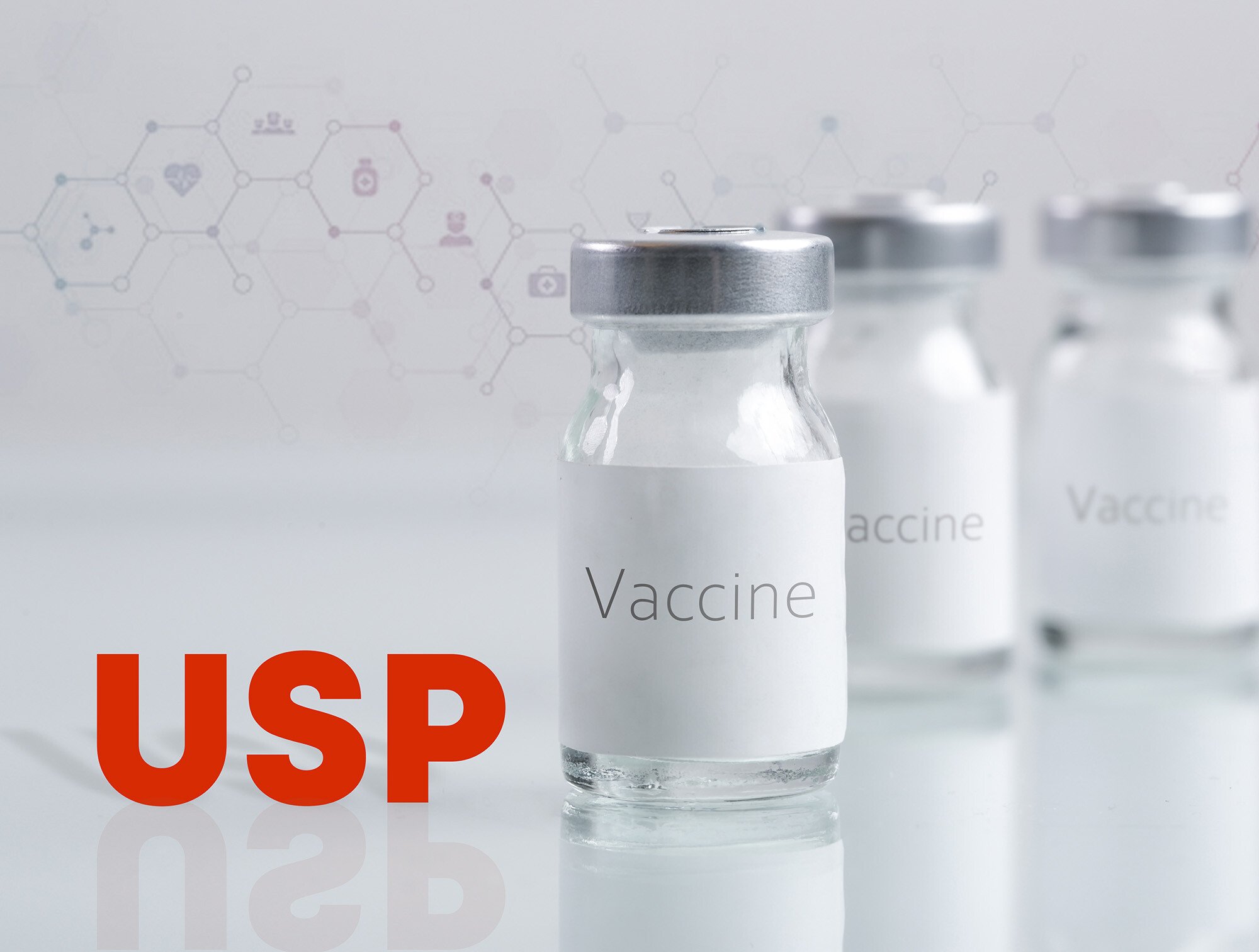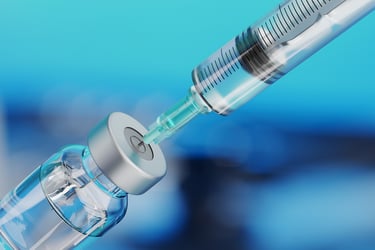All biotherapeutics contain particulate matter, defined by the United States Pharmacopeia (USP) as mobile undissolved particles that are unintentionally present in the drug product solution. Particulate matter includes subvisible particles or those between 2-100 μm in diameter. Subvisible particles in biologics have been associated with changes in product safety and efficacy in the clinic, including adverse reactions ranging from capillary occlusion to immune reactions.
To mitigate these risks for patients, USP <788>1, <787>2, and <789>3 pose limits on the subvisible particle content that is acceptable in parenteral drug products. The table below summarizes these requirements. This post will introduce these chapters and discuss how FlowCam, a flow imaging microscope, can help ensure each batch of drug product meets pharmacopeia requirements.
Download the White Paper: USP Reference Standards for Subvisible Particulate Matter

USP <788> Particulate Matter in Injections
USP <788> is the most broadly applicable of the USP chapters as it applies to any parenteral drug product. This chapter is also harmonized with EP29.9.19 and JP 6.07 in the European and Japanese Pharmacopeias, respectively. While the chapter is specific to monitoring particles in pharmaceuticals, particle shedding from medical devices like syringes, infusion pumps, and implantable devices is also often tested to this standard.
To meet the requirements in this chapter, the subvisible particle content in each batch of drug product must be tested as part of normal lot release and quality control tests. At least 25 mL of sample volume is required for this testing.
Two compendial methods are specified for this test: light obscuration (LO) and membrane microscopy. The light obscuration method is the preferred test under most circumstances due to its ease of use and in-solution measurements. The acceptable particle limit for this test depends on the drug product volume. Most biotherapeutics are ≤100 mL in volume and must contain no more than 6000 particles ≥10 μm and 600 ≥25 μm per container when tested via LO to comply with this chapter.
The membrane microscopy method (referred to as the “microscopic” test in USP <788>) is a secondary analytical test for subvisible particles. It is used when the LO method is inappropriate for a given drug product, such as for therapies with high viscosity or a non-transparent formulation buffer. It is also sometimes used to confirm that a batch of drug product meets USP <788> requirements, but it cannot be used to “pass” a batch that has previously failed the light obscuration method. For most biologics, the drug product must contain no more than 3000 particles ≥10 μm and 300 ≥25 μm per container when tested to this method for compliance. Since membrane microscopy can partially remove some particle types, such as protein aggregates and silicone oil droplets, the particle counts and concentrations must be significantly lower via membrane microscopy than via light obscuration to meet USP <788> criteria.
USP <787> Subvisible Particulate Matter in Therapeutic Protein Injections
While it is applied to all injectable drug products, USP <788> was originally developed for small-molecule therapies. As protein therapeutics became more commonplace, there was a need to develop subvisible particle monitoring strategies tailored to protein drug products and the unique challenges they pose for particle monitoring. All protein therapies contain some subvisible protein aggregate particles, which are thought to pose higher risks to patient safety than many other particle types. Aggregates are often challenging to analyze via membrane microscopy due to their fragile, “soft” structure. Additionally, many protein therapies are much lower volume than small molecule therapies, making it difficult to meet the volume requirements of the methods in USP <788>.
USP <787> is an alternative test to USP <788> designed to analyze protein therapies' subvisible particles. It is based on the light obscuration method in USP <788> and has the same subvisible particle limits as that method. However, it allows a wider range of sample volumes to be used in testing, between 1 and 25 mL. Due to the challenges of processing protein aggregates with membrane microscopy, the light obscuration method is strongly preferred for these therapies. It is the only explicitly provided method in this chapter.
USP <789> Particulate Matter in Ophthalmic Solutions
USP <789> is a variant of USP <788> that is specific to ophthalmic drug products delivered intraocularly, including common delivery routes for protein and gene therapies like intravitreal and subretinal. Note that extraocular injectable drug products still require subvisible particle monitoring but are instead subject to USP <788> requirements. More information on which chapter applies to a specific ophthalmic delivery route can be found in USP <771>.
Subvisible particles often impact the efficacy of ophthalmic drug products more than other therapies, as they can cause patients to see floaters following administration. As a result, these treatments are subject to more stringent limits on subvisible particle content than other parenteral drug products. All intraocular ophthalmic drug products must contain no more than 50 particles / mL ≥10 μm, 5 particles / mL ≥25 μm, and 2 particles / mL ≥50 μm—regardless of sample volume or testing method. Since these limits are always on a per-volume basis, small-volume ophthalmic drug products must have many fewer particles than other parenteral drug products of the same volume.
How flow imaging microscopy relates to USP <788>, <787>, and <789>
Flow imaging microscopy (FIM) is not one of the compendial methods in the USP chapters. FIM instruments like FlowCam can technically be used as a primary lot release test, but doing so requires much more extensive method validation than the compendial techniques require. As a result, researchers will generally use one of the two compendial techniques—usually light obscuration—as their primary lot release assay. Despite not being a compendial method, FIM is a recommended orthogonal technique for LO and membrane microscopy, as indicated in USP <1788>, due to its insight into particle morphology, type, and source. FlowCam measurements can support lot release and quality control efforts by helping researchers with root cause analysis after batch rejection. Samples failing the compendial tests often indicate the appearance of a new subvisible particle source in the manufacturing process. FlowCam instruments can capture images of these unexpected particles to help determine their type and source. Researchers can use this information to identify and address the underlying process upset to ensure subsequent batches meet pharmacopeia requirements. This approach can also be used to proactively monitor particle populations in accepted batches to identify and mitigate novel particle sources before they cause batches to be rejected.
FlowCam LO allows researchers to easily integrate FIM into their routine quality control process. This unique instrument allows researchers to collect FIM data alongside their LO measurements with a single instrument and no additional sample volume. Combining these methods allows researchers to meet pharmacopeia requirements while capturing particle morphology information to monitor particle types and sources. Additionally, FlowCam LO can be combined with ALH for FlowCam to automate LO measurements, thereby improving the repeatability of these important lot-release tests.
USP <787>, <788>, and <789> help ensure that all parenteral drug products contain low concentrations of subvisible particles, minimizing the safety risks they pose for patients. Flow imaging microscopy instruments like FlowCam LO provide valuable particle morphology information that can help ensure that every drug product batch meets these important product quality requirements.
To learn more about using flow imaging microscopy as per USP recommendations, explore the resources on our website, including the FlowCam LO brochure and our white papers on topics like orthogonal methods.
References:
- United States Pharmacopeia. USP <788> Particulate Matter in Injections.
- United States Pharmacopeia. USP <787> Subvisible Particulate Matter in Therapeutic Protein Injections.
- United States Pharmacopeia. USP <789> Particulate Matter in Ophthalmic Solutions.










